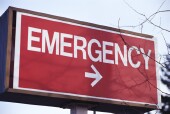
WEDNESDAY, Feb. 27 (HealthDay News) — Of the 10 most common outpatient conditions treated in U.S. emergency departments, urinary tract infections and kidney stones can be the most expensive, according to a new report.
For most Americans, however, the cost of their emergency visit remains a mystery until the hospital bill arrives, the researchers pointed out.
The findings of the new study are from an analysis of data from more than 8,000 outpatient emergency-department visits made by adults aged 18 to 64 between 2006 and 2008 in the United States. The charges — which include medical care, tests and treatment — are not the amount patients or insurers pay hospitals, but rather the total charge that patients or insurance providers were billed.
The median charge for all 10 conditions was $1,233, while the median price was highest for kidney stone conditions ($3,437) and lowest for upper respiratory infections ($740). Uninsured patients had the lowest median charge ($1,178), followed by those with private insurance ($1,245) and Medicaid ($1,305), the investigators found.
The researchers, from the University of California, San Francisco, also found wide variations in out-of-pocket patient charges for the 10 conditions, ranging from $50 to $73,000 for urinary tract infections, $128 to more than $39,000 for kidney stone treatment, $29 to more than $29,000 for intestinal infections, $4 to $24,100 for sprains and strains, and $15 to nearly $18,000 for headache treatment.
Most emergency-department visits were for sprains and strains, other injuries, open wounds, high blood pressure, asthma or high cholesterol, according to the study, which was published online Feb. 27 in the journal PLoS One.
“Our study shows unpredictable and wide differences in health care costs for patients,” senior author Dr. Renee Hsia, an assistant professor of emergency medicine, said in a university news release.
“Patients actually have very little knowledge about the costs of their health care, including emergency visits that may or may not be partially covered by insurance. Much of this information is far too difficult to obtain,” said Hsia, who also is an attending physician in the emergency department at San Francisco General Hospital and Trauma Center.
About 20 percent of Americans visit an emergency department each year. Rising emergency-department costs lead to higher deductibles and co-payments for patients with health insurance, and a larger proportion of self-pay responsibility for those without insurance, the researchers said in the news release.
With rising health care costs and a growing burden of medical debt among Americans, there needs to be more transparency in hospital charges, and patients need to be better informed about the costs of their medical care, the researchers said.
“While most patients with time-sensitive conditions — such as [heart attack], stroke or sepsis — may not be in a position to make decisions about their care based on costs or charges, there are many situations in which patients could reasonably inquire about the potential financial implications of their medical care before making treatment decisions,” the study authors concluded.
More information
The American College of Emergency Physicians outlines when you should go to the emergency department.

